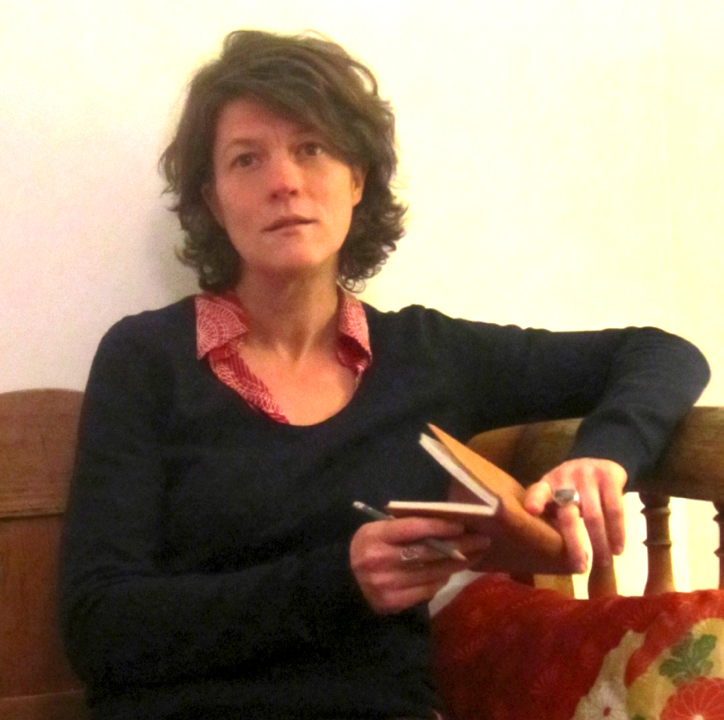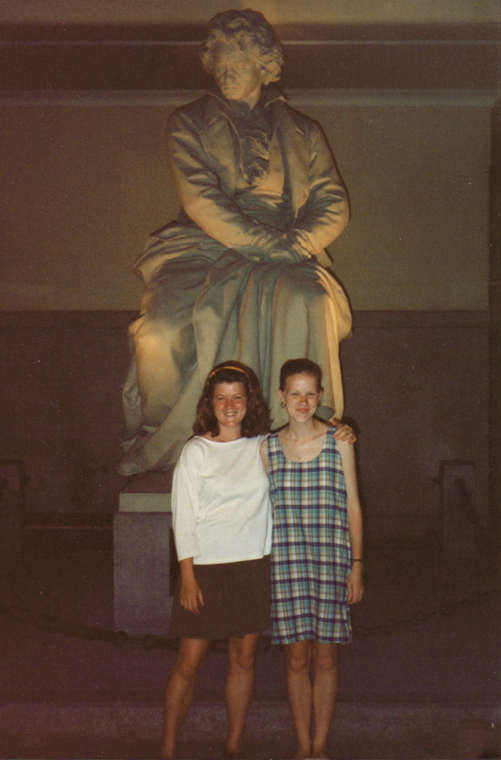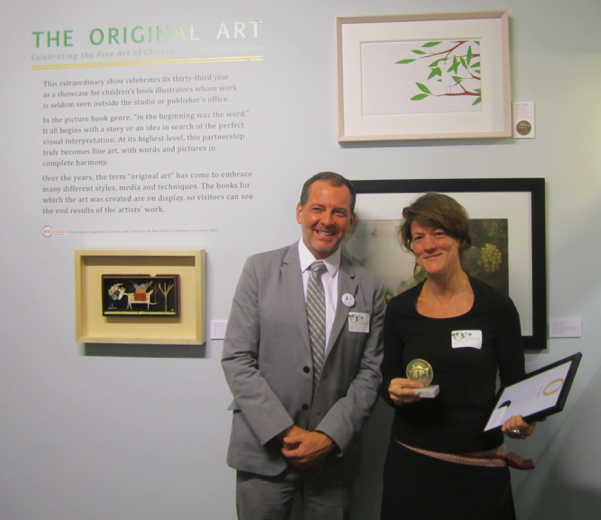While Iowa City native Jennifer Yerkes (BA art ’93) stuck close to home for her undergraduate career at the University of Iowa, she took full advantage of study abroad experiences to expand her worldview. Those early study abroad experiences—one in Austria, another in Hungary—led to a lifetime of learning, living, and working abroad.

Jennifer Yerkes
After graduating from the University of Iowa, Yerkes returned to Hungary as a Fulbright scholar. She then accepted a full-ride scholarship at the University of Glasgow in Scotland where she began work for her graduate degree in art history. Yerkes currently lives in Strasbourg, France, where she works as a freelance graphic designer, illustrator, and author. Her work has won several awards, including: First Prize, Main à la pâte Award (Elementary School category); Opera Prima Ragazzi Award, Bologna Children’s Book Fair; Gold Medal, Society of Illustrators Original Art Awards; and numerous shortlists for other children’s book prizes.
We caught up with Yerkes recently to learn more about the influence of her UI study abroad experiences, her current work, and advice she has for current UI students.
What inspired you to study abroad?
When I was very small, my family lived in Turkey for several years. When we moved back to the United States, I was “homesick” for that other life — the only life that I could remember — for a long time afterwards. We eventually moved to Iowa City, so that my parents could study for their graduate degrees, and I loved loved loved growing up there. In fact, I’m sure that if I hadn’t always felt that wanderlust that my early childhood experience had created, I would very likely have stayed in Iowa City; and if I hadn’t found love in France, I may very well have moved back there, eventually.
Language, it seems to me, is like music. If you listen carefully, and let it sink in, a language’s cadence and structure are fairly simple to pick up. The real work is in acquiring vocabulary. But I knew that if I went abroad, the vocabulary would be easier to assemble.
It is possible that those early childhood experiences are also at the root of my love of languages, and the relative ease that I have for picking them up. Language, it seems to me, is like music. If you listen carefully, and let it sink in, a language’s cadence and structure are fairly simple to pick up. The real work is in acquiring vocabulary. But I knew that if I went abroad, the vocabulary would be easier to assemble.
While studying art and art history, as well as German, at the University of Iowa, a number of things happened that resulted in my going abroad. For one thing, I had a magnificent German professor, Margee Miller, who was using a new method to help us advance more quickly in our ability to speak. I also had a magnificent art history professor (one of several*), Anne Roberts, who told us one day, as we were looking at slides of cathedrals in France and Germany, that it was one thing to look at images of them projected on the wall or in books; but if we were going to go any further in the field of art history, it was of vital importance to experience them up close and in person. These two chance meetings were really what sealed the deal for me.
I was also learning Czech on the side, with a group in Cedar Rapids. So when tickets abroad became unbelievably cheap during the first Gulf War, I snapped one up and met friends in Berlin during summer vacation. We travelled from there to various cities in Germany, Czechoslovakia (as those two countries were still known then), and Poland. Not only did I realise just how right Anne Roberts had been… I was absolutely astounded to see so much art and architecture that I’d never seen at home — and wanted to know more. So when classes started in autumn 1991, I asked Stephen Foster if he would mentor me, and oversee some writing I wanted to do about Eastern European art history. While searching for a more well-defined subject, I found my academic heart’s desire in a few rather obscure books about Hungarian art history, written by American, French, and German scholars. And the more I studied, the more I knew that my academic future lay in Hungary. Especially since I was passionate about the subject, but it seemed that the non-Hungarian scholars were getting their information from the same sources — and it wasn't clear whether they actually spoke or read Hungarian. So I’d have to get to Hungary — and learn Hungarian — to go any further in this field.
Hungarian wasn’t one of my languages — not yet — but I was told that if I could speak German, I’d be alright in Hungary until the language was acquired. So I applied for the summer study abroad program in Austria in 1992, and for a year-long program in Pécs, Hungary, (in which we could learn Hungarian, and at the same time take classes in English about Hungarian social, political, literary, musical and artistic history) for my final undergraduate year of university. And these experiences were absolutely immense. I cannot stress enough how incredible and even life changing they were.
* All professors mentioned above and below were magnificent — as were many who aren’t mentioned, here.

Jennifer Yerkes with her sister, Ellen, in front of a statue of Beethoven in Vienna, Austria. This photo was taken during Yerkes’s study abroad experience; Ellen was visiting.
What lessons did you learn from your study abroad experience at Iowa? What did you gain as a result of studying abroad?
The very first thing I learned was a different kind of deep compassion and understanding than I’d ever experienced before. I arrived a few days early in Graz, and stayed in a youth hostel that was housing families fleeing the war in Yugoslavia. That first evening, we all sat at a huge table, eating dinner and watching the news. German was the lingua franca at that table, but so were the sad faces, hugs, and tears, as we watched the segments about the war. The director of the youth hostel ate with us, and I’ll never forget how kind and helpful he was to these families.
(Up until about a week before I got there, you could go up into the mountains around Pécs and watch the “fireworks” display that was happening over the border. The incalculably abysmal divide between the description of how it looked from afar and the reality of it is still with me today, along with the stories of those who fled the war and the “casques bleu,” who would spend their occasional 72 hour furloughs in Pécs. The war had moved farther away from the border by the time I arrived, but it was still raging on.)
While studying in Sankt Radegund, a realisation of just how big life is, and how precious every moment (and every person) is, really began sinking in. We met so many lovely people there, and they all adhered strictly to Herr Koppensteiner’s request that they speak only German with us. We made friends and bettered our German quickly and organically there. It was brilliant.
During our break, before moving on to Vienna, I spent some time travelling alone. I’d never done this before, and it taught me a lot, very quickly, about self-reliance, going with the flow, and following your instincts. It also deepened my feeling that the further you allow yourself to move from the centre, the more and better you learn.
Speaking of following your instincts: that first year in Pécs taught me that my instincts had been right, and that choosing a smaller city was a very good way to make sure that you learn (or at least start learning) a language. There were relatively few foreigners in that city, and also relatively few Hungarians who spoke English. So another thing I learned was Hungarian!
To sum it up, though, I’d say that I learned an enormous amount about who I was, my place in this world, and what I wanted to do and how I wanted to do it. And in learning these things about myself, I learned a lot (perhaps even more) about others, otherness, our similarities, and their cultures, as well. I also began learning about the vast number of possibilities that are out there, just waiting for you to grab them and run. And to better trust my instincts.
By studying in other countries, I also benefitted from the knowledge and experience of people who had a completely different background from my own. This broadened my understanding of much more than what I was initially studying, and made me a more critical thinker.
How did study abroad complement your major and education at the UI?
By bettering my German and learning Hungarian, I was able to read original documents important to my studies, most of which were not available in translation.
By studying in other countries, I also benefitted from the knowledge and experience of people who had a completely different background from my own. This broadened my understanding of much more than what I was initially studying, and made me a more critical thinker. I liken this to something one of our professors at the University of Iowa said to us, I believe because somebody had wondered aloud about why those who wished to study art history had to take art classes, too (if memory serves, it was Richard De Puma; in any case, I paraphrase): If you are critiquing art, it is to your benefit to have some artistic training, in order to better understand the technical processes that lead to the final piece.
Tell us about your Fulbright experience.
I had a research award that allowed me to start delving into the life and works of the self-taught artist, poet, novelist, essayist, editor and theoretician of the avant-garde, Lajos Kassák (1887-1967). There was so much to learn… I was very glad (and honoured) to have been awarded an extra semester’s extension after that first year!
During that time, I lived in Budapest, but split my time between that city and Pécs, where my mentor, Tomás Aknai, was based. I would attend classes at the Eötvös Loránd University, do research at the museums, and hang out with the art history scholars I met there. And I was able to amass a number of art historical and other pertinent writings in Hungarian, including a copy of the four volume collection of Kassák’s artistic review, MA. These books all have a special place in my personal library.
The Fulbright team in Budapest was a really great group of people, and the scholars were so varied. We spent a good chunk of time together, and I’d say we ended up learning a lot from one another, on top of whatever it was that we were there to research. For instance, I learned a lot about the mind and ways of working and learning from conversations with a young mathematician and a young musician in our group.
When the Fulbright ended, I applied to the art history graduate program in Glasgow, Scotland, where I continued my work on Lajos Kassák, until I realised that although I loved studying and writing about art history, and was passionate about my subjects, what I really wanted to be doing, professionally, was graphic design and illustration. So I followed my instincts again.
Go-travel-live-learn... Pay special attention to your language learning... And experience as much as you can of the arts and the countryside of wherever you go.
Can you tell us a little about your path from graduation to your current job?
After my time in Glasgow, I moved back to Strasbourg, France (where I’d lived after obtaining my BA, until I was awarded the Fulbright grant). I worked first as a graphic designer in an ad agency. After this experience, I began working freelance on graphic design and illustration projects for many and various cultural institutions and projects. In 2010, after spending years piling up ideas for children’s books, I finally had one that seemed not only viable, but somehow original. It was sent to Éditions MeMo (Nantes, France), and picked up immediately. That first book, Drôle d’oiseau, garnered two major awards (Bologna Ragazzi Opera Prima + Original Art Gold Medal), was shortlisted for others, and has been published in 8 languages thus far, including English (Funny Little Bird; ed. Sourcebooks Jabberwocky, NYC). Thanks to this magnificent first experience, my work has been tending more and more towards children’s book writing and illustrating ever since. Two books with the Swiss publishing house Éditions Notari (Geneva) followed, and one of them found itself on several important European shortlists; a fourth book called Red Light, Green Lion, written by Candace Ryan and published by Kids Can Press (Toronto, Canada), came out on the shelves in May this year; a book I wrote and illustrated will be published by Les Grandes Personnes (Paris, France) in October this year; and another will be published by Éditions Notari in March 2020.

Jennifer Yerkes with Steve Geck, editor at Sourcebooks Jabberwocky, who published the North American version of Drôle d'oiseau, her first book.
I also teach and do workshops with kids and adults of all ages. It is an aspect of my work that I really enjoy, not only because of what I’m able to teach others, but also what others teach me during these experiences. The workshops in particular are fantastic. You have conversations and see others’ ways of working out solutions that are often not only brilliant, but also rather humbling. It is actually in great part thanks to this work that I came up with the idea for my first book. I was working on a series of workshops for very small children in what they called a “Priority Education Zone” in Strasbourg, and the idea grew naturally out of those thoughts, and turned into Drôle d’oiseau.
How has your international experience benefitted you in your current job?
My work as a designer and illustrator has benefitted from all of my studies, all of the countries and cultures I have lived in and travelled through, and the experiences I’ve garnered throughout my life, both in the USA and abroad; and frankly, my work as a children’s book writer and illustrator may never have come to any real fruition without those experiences. I cannot underline this enough.
Your boundaries inevitably widen when you travel; when you are able to study in different cultural settings, with their varying cultural and societal perspectives; and when you can read and speak with people in a language that is their mother tongue (and not yours). This isn’t something you necessarily think about all the time in your day to day life. But for instance, in my case, when I look back at any particular work I’ve done, I always see a broader spectrum of origins than I was actively considering while actually doing the work, and my international experience has always played a very big part.
And in the case of my work as a children’s book writer and illustrator, I am absolutely certain that I wouldn’t even be doing what I am currently doing, if it weren’t for the fact that I live in Europe; and more to the point, in France. What is expected of children’s books here is very different and much less restrictive than what is has generally been expected of them in North America over the past several decades, for one thing. And for another, there was everything that led to me being in this culturally rich spot at the right time. It wasn’t until the first of my children’s books was published that I realised just how much of all of that had gone into that one little book.
Do you have any advice for current UI students regarding study abroad?
Go-travel-live-learn... Pay special attention to your language learning... And experience as much as you can of the arts and the countryside of wherever you go.
To learn more about Yerkes and her work, see https://cargocollective.com/jennifer-yerkes.